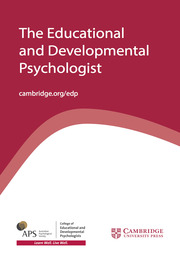This will be the first issue of The Australian Educational and Developmental Psychologist (AEDP) that will be published by Cambridge University Press. This will mark a significant step forward in ensuring that the work that this journal publishes is given a more international audience, thus ensuring that quality Australian research is viewed more widely. Over time, there should be an increase in international authors who submit to the journal, thereby providing a wider focus for discussing practice and academic issues in educational and developmental psychology. In this issue, all five articles have a focus on children and adolescents, and provide an eclectic overview of interventions and research that will benefit this group. Kavanagh, Freeman, and Ainley present findings from their study on teacher–student interactions, which demonstrates that adolescent boys appreciate positive feedback and a helpful and caring environment in the school. Continuing the focus on adolescents, Martinez, Martin, Liem, and Colmar consider, through a longitudinal study, the link between physical health and psychological wellbeing at the crucial transition stage between leaving school and postschool life. Their study places value on ensuring that postschool wellbeing is prepared for while still in the school sector. In a world of ever-increasing electronic interconnectivity, Neira and Barber provide a timely article that suggests that adolescents do not gain the same level of positive developmental experiences from online social networking when compared to traditional leisure activities. Despite the rapid advance of social networking for all ages, it is an interesting finding that a balance is needed with the physical world. McDonald, Moore, and Anderson discuss the positive benefits derived from using different types of functional assessment on a child with autism, and discuss the usefulness of one approach to positively improve desired behaviour in the case-study child. Finally, Hamilton and Wyver discuss the importance to parents of the New South Wales Child Personal Health Record and how this can be better improved to provide more support to the parents when the perceived need is greatest.
As the Acting Editor, I would like to acknowledge the work that the previous editor, Terry Bowles, has done over the preceeding 5 years in ensuring that the journal continued to be a respected publication for the profession of Educational and Developmental Psychology in Australia. Terry has kindly agreed to remain on the Editorial Board.




